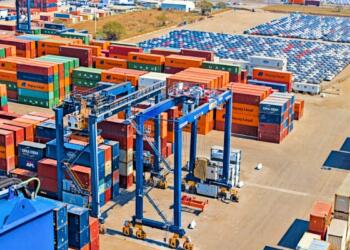
PUERTO VALLARTA, JAL.- On July 11, 2019, the then Ministry of Communications and Transportation (SCT) published a statement confirming that the Mexican government was considering expanding the port of Manzanillo in the Cuyutlán Lagoon , a measure that sought to deal with the saturation in the operation of the Colima port.
A little more than five years after that announcement, the Mexican port sector is still waiting to learn the details of that project , given the considerable increase in saturation not only in Manzanillo, but in other deepwater ports in Mexico that have observed substantial increases in the handling of containerized cargo and other goods in their statistics.
The SCT (now the Secretariat of Infrastructure, Communications and Transport – SICT) expansion project includes the construction of four new terminals: one specialized for containers (TEC) with the capacity to handle 1.75 million 20-foot containers (TEU) per year, another for agricultural bulk, one more for mineral bulk and one specialized for hydrocarbons.
“It will be a very important project. We need to know the details of the plans for Cuyutlán (…) it is the future of the port of Manzanillo,” said Manuel Fernández Pérez, general director of SSA Marine México , during his participation in the panel “Port Terminals, a crucial link” held at the XXVIII Annual Congress of Shipping Agents, organized by the Mexican Association of Shipping Agents (Amanac) .

SSA Marine México, from the American Carrix Group , a private operator that in the last 30 years has won various concessions in the country’s ports for the handling of specialized cargo, such as automobiles, containers and other types of merchandise, as well as passengers, in Manzanillo, Lázaro Cárdenas, Tuxpan, Veracruz and Progreso.
Manuel Fernández considered that Mexican ports currently have a wide possibility of growing in a sustained manner in the coming years through investment in infrastructure, given that 35% of the demand for imported goods for the domestic market is transported by sea, and “it is a number that should not be ignored” , as well as due to the proximity to the United States, the main commercial partner, and the free trade agreements that exist with other countries in the world.
But the executive indicated that the maritime-logistics market is waiting for the increase in demand that could arise from the nearshoring trend (relocation of production lines to the country), despite the fact that official statistics have reiterated that Foreign Direct Investment last year and this year have mostly been reinvestments . “We still do not see the massive arrival of new companies and that is an unknown that we need to resolve to see if nearshoring will be a reality or not,” he said.
Meanwhile, voices in the maritime port sector have indicated that the new federal administration, headed by Claudia Sheinbaum, would have the Cuyutlán Lagoon project among its public investment plans for this year , at a time when different port terminals are applying investments in their facilities to expand the infrastructure that has been surpassed by the demand of foreign trade in Mexico.
“It is no secret that the previous government (of Andrés Manuel López Obrados) did not put much interest in investing in port infrastructure, outside of the magnanimous project that who knows if one day the transisthmian will be launched,” said Francisco Orozco, Commercial Director of Hutchison Ports Holdings México , another of the port groups with a wide presence in the country, with facilities in Ensenada, Manzanillo, Lázaro Cárdenas and Veracruz.
Likewise, with the change of government, the Mexican maritime port sector expects that there will also be a change in the designation of civilian personnel to head the administration of the ports , since, according to them, the introduction of elements of the Navy has brought about a setback in their development.
Meanwhile, Beatriz Yera, general director of APM Terminals Mexico , with port concessions in Lázaro Cárdenas and Progreso, considered that the port system requires joint work to increase efficiency in operations , especially at times when the fragility of the system is observed when seasonal hurricanes force ports to close activities for days.
“Our response as actors in the entire chain to ensure that solutions arrive as quickly as possible (…) does not depend on external factors in many cases, I feel that it depends on each one of us,” he said.
In turn, Omar Lima, director of Terminals of Grupo CICE , indicated that in this regard, government management is very important and that all actors in the chain are aligned with the nation’s project.
” Our authorities must invest in basic infrastructure, which is necessary to provide certainty for investments,” said the director of CICE, which is present as a port operator and terminal concessionaire in Veracruz and Tampico.
Comment and follow us on X: @EnriqueDuRio /@GrupoT21














